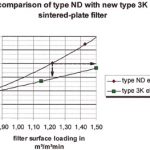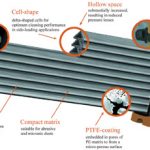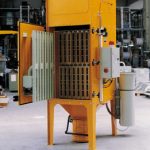Filtering-type separators are generally re-cognized as having an enormous development potential. The prevailing trend is in favour of surface filtration where fine-pore surface structures warrant a low dust content in the clean gas. The overall size of the equipment is reduced by the use of self-supporting elements.
Dr.-Ing. Hans-Joachim Adlhoch, Dr.-Ing. Urs Herding, Dr.-Ing. Johann Weitl
The last 20 years have seen a substantial reduction in the size of sintered-plate filters. To start with, flexible fabric tubes or bags were combined to form multiple-tube elements. Later the flexible tubes were replaced by coated plastic tubes, thus leading to the first filter consisting of a rigid matrix with a porous coating for surface filtration. Continuing developments resulted in the tubes being replaced by contoured matrices made of sintered polyethylene. This concept has permitted a 40 to 50% increase in filter area with the same size of elements and compact design.
The use of chemically resistant materials for the sintered-plate filters has also made them attractive as process filters in the chemical industry. The BIA-tested, anti-static filter versions, for instance, can be used without any reservations for handling combustible or explosive dusts.
Hitherto, the only disadvantage of the sintered-plate filters lay in the fact that the pressure loss was relatively high. This drawback has now been overcome.
Significant reduction in filter resistance
The use of new plastics formulations has made it possible to achieve a more uniform pore size distribution within the sintered polyethylene matrix and, as a result, to increase the d-50 value by 50%. In addition, the manufacturer has succeeded in the case of the type 3K filters in combining the higher permeability of the matrix with a homogenized PTFE surface coating. This has led to the pressure losses in the 3K filters being re-duced by about 40% under comparable operating conditions (Fig. 1). To the user, this means a reduction in power consumption costs of up to 40% or, alternatively, a 20% reduction in filter area for the same filter capacity.
Classification as HEPA filters
Previously, the BIA tests recorded separa-tion efficiencies that placed the 3K filters in the C category. In the meantime these filters have obtained classification under DIN 24184 as class R HEPA filters (High Efficiency Particulate Air Filter). It follows that they can now be used directly as safety filters, and in many instances there is no longer any need for a downstream HEPA filter. Mechanical damage that might cause dust penetration can be excluded for all practical purposes due to the structure of the filter matrix and its coating. What might happen under worst conditions is that the filter element could be blinded. However, a failure of this kind would be easily detect-able by means of a differential pressure indicator.
Should blinding occur in the 3K filter, it would be unproblematic to clean the filter surface by washing. Where the production process involves product changes, it is a good idea to incorporate CIP (cleaning in place) cleaning of the filter surface. Another important aspect is that the 3K filters can be conveniently regenerated in an ecologically compatible regenerated with the matrix being reused.
Frequently, no information is available regarding whether or not the product that is to be filtered tends to stick or bake. In such cases, precoating the filter elements is an effective solution. The manufacturer has developed a special coater that can be directly attached to the filter plant. With the exception of a single valve, the coater has no moving parts, so that wear and maintenance are minimized.
Side-loading filter elements
A precondition of economical operation of compact filter elements is that the associated equipment should be optimally matched to the filter medium. It has been general practice up to now to design the flow pattern, plenum zones and integral pre-separators on the basis that the filter elements will be installed vertically from the top or bottom, i.e. from the raw gas or clean gas side. In contrast to this, the delta-type filters permit lateral installation (Fig. 2). Except for their delta-shaped contour, the layout and separating characteristics of these filters are similar to those of the existing filter elements. The delta-shaped contour guarantees optimum and reliable separation, with the possibility of loading the elements from the side. Delta filters are at a premium where low headroom is a crucial factor, for instance when process filters have to be retrofitted in existing plants. Conversely, they lend themselves very well to applications where the available base area is small but a great height is possible. In this case several filter elements can be stacked on top of each other (Fig. 3).
Type 3K sintered-plate filters have proved particularly successful when used to recover paint powders. They allow the cleaned exhaust air to be directly returned to the working space. Moreover, the use of the 3K filters leads to a distinct reduction in power requirements. The 30% reduction in filter resistance has actually been verified under field conditions.
Herding
Fax: ++49/9621/630 120
Further information cpp-289
Unsere Webinar-Empfehlung
Der Webcast MTP und modulare Produktion bietet eine einzigartige Gelegenheit, mehr über die aktuellen Entwicklungen bei MTP und in der modularen Produktion zu erfahren.
Chemie- und Pharmaproduktion braucht mehr Flexibilität
In der heutigen sich schnell wandelnden Welt stehen…
Teilen:













